

Compact Muon Solenoid
LHC, CERN
| CMS-PAS-EXO-22-006 | ||
| Search for lepton flavour universality violation via production of a new neutral gauge boson decaying to two muons with one or two b-jets in pp collisions at √s= 13 TeV | ||
| CMS Collaboration | ||
| 19 July 2024 | ||
| Abstract: A search is presented for a new neutral boson, Z', produced in association with one or two jets, including at least one b jet, and decaying into two muons. Current exclusion bounds on this signature are looser than those for Z' produced via light quark fusion. The analysis is performed using data collected in 2016--2018 with the CMS detector in proton-proton collisions at √s= 13 TeV and corresponding to an integrated luminosity of 138 fb−1. No significant deviation from background expectations is observed. Limits at 95% CL on the product of cross section, branching fraction, and acceptance are set, ranging from 0.2 to 2 fb, for Z' masses between 127 and 352 GeV. Model-independent upper limits on signal yield and generator-process-dependent acceptances are provided. | ||
| Links: CDS record (PDF) ; CADI line (restricted) ; | ||
| Figures | |
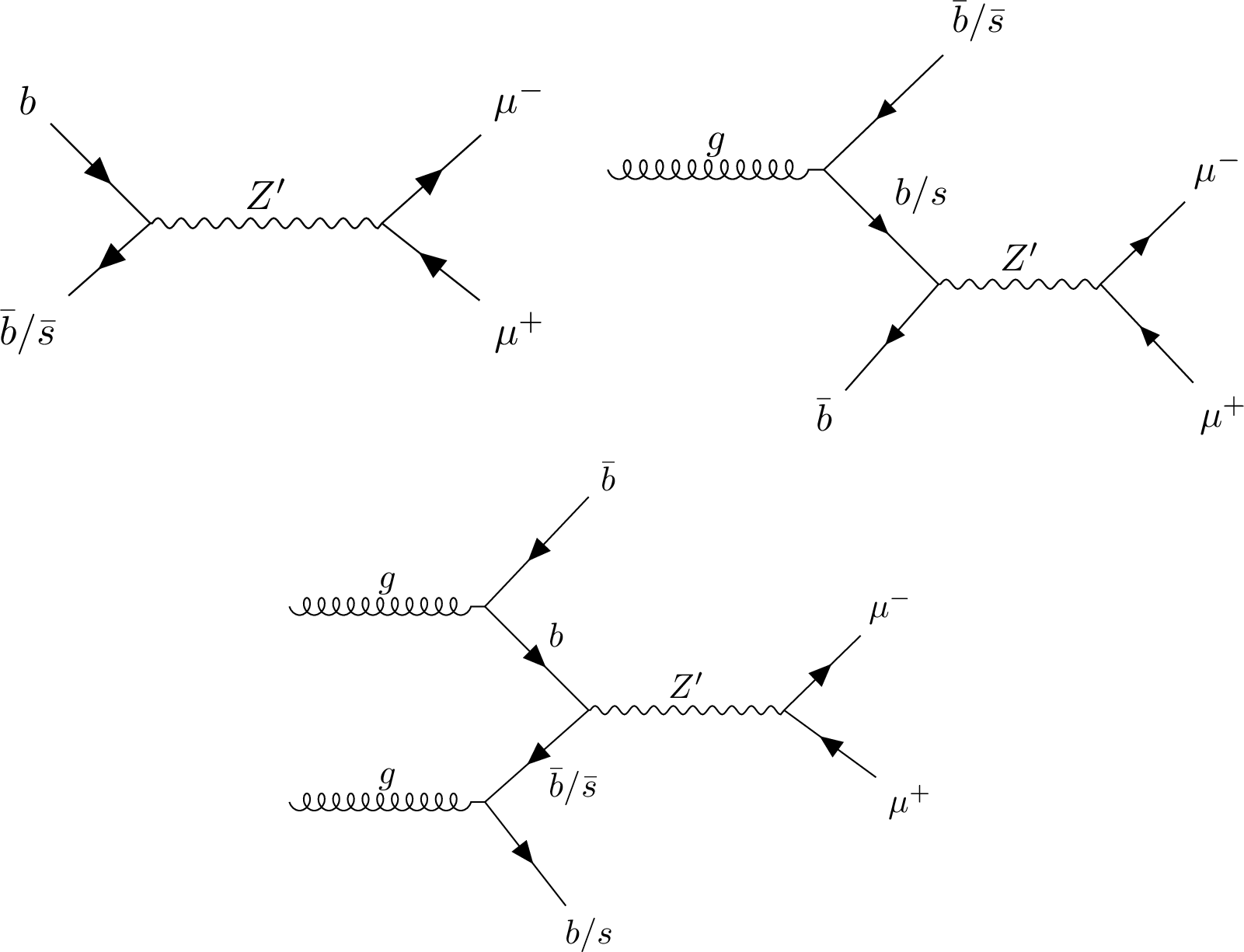
png pdf |
Figure 1:
Representative Feynman diagrams of Z' production via bottom-bottom or bottom-strange quark fusion and decaying in a dimuon final state. Tree-level production (left), single associated initial state radiation (ISR) jet production (middle), and two associated ISR jet production (right) are shown. |
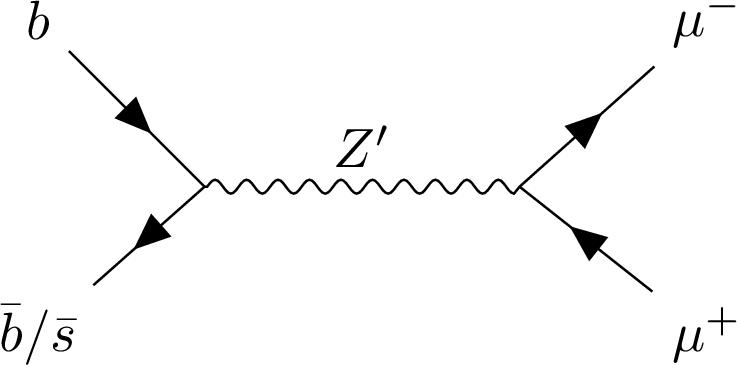
png pdf |
Figure 1-a:
Representative Feynman diagrams of Z' production via bottom-bottom or bottom-strange quark fusion and decaying in a dimuon final state. Tree-level production (left), single associated initial state radiation (ISR) jet production (middle), and two associated ISR jet production (right) are shown. |

png pdf |
Figure 1-b:
Representative Feynman diagrams of Z' production via bottom-bottom or bottom-strange quark fusion and decaying in a dimuon final state. Tree-level production (left), single associated initial state radiation (ISR) jet production (middle), and two associated ISR jet production (right) are shown. |
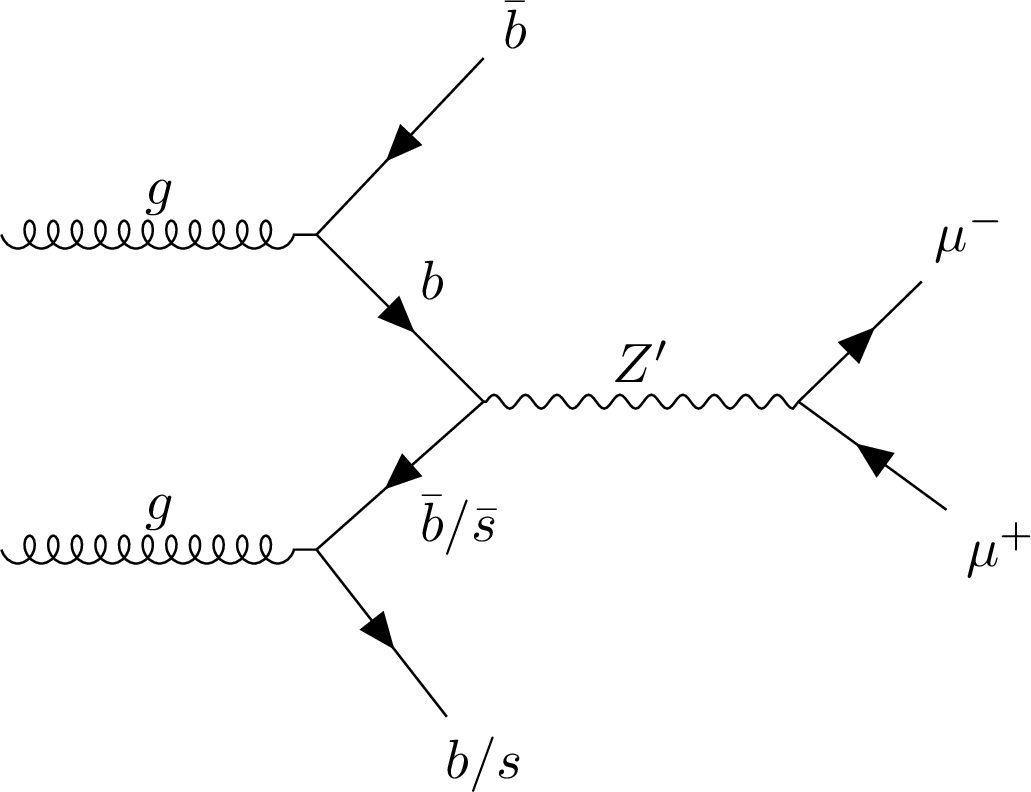
png pdf |
Figure 1-c:
Representative Feynman diagrams of Z' production via bottom-bottom or bottom-strange quark fusion and decaying in a dimuon final state. Tree-level production (left), single associated initial state radiation (ISR) jet production (middle), and two associated ISR jet production (right) are shown. |
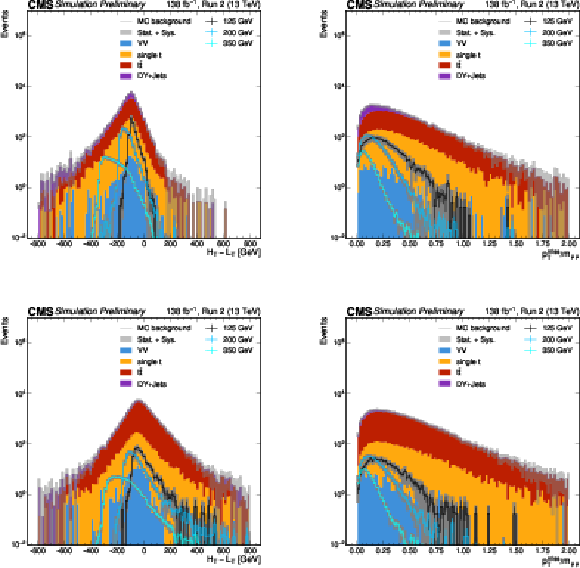
png pdf |
Figure 2:
Histograms for search-specific variables after object selections including a single muon requirement and categorization into both jet multiplicities in Run 2 simulation. HT−LT distributions are on the left, pmissT/mℓℓ distributions on the right. 1-jet category distributions are on top, 2-jet category distributions on the bottom. |

png pdf |
Figure 2-a:
Histograms for search-specific variables after object selections including a single muon requirement and categorization into both jet multiplicities in Run 2 simulation. HT−LT distributions are on the left, pmissT/mℓℓ distributions on the right. 1-jet category distributions are on top, 2-jet category distributions on the bottom. |
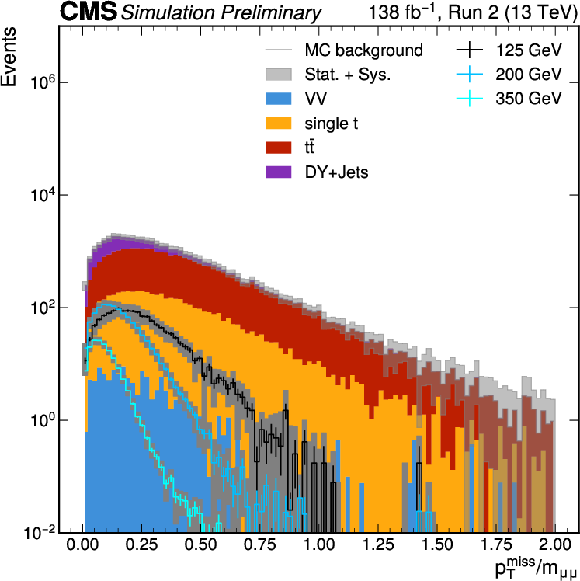
png pdf |
Figure 2-b:
Histograms for search-specific variables after object selections including a single muon requirement and categorization into both jet multiplicities in Run 2 simulation. HT−LT distributions are on the left, pmissT/mℓℓ distributions on the right. 1-jet category distributions are on top, 2-jet category distributions on the bottom. |
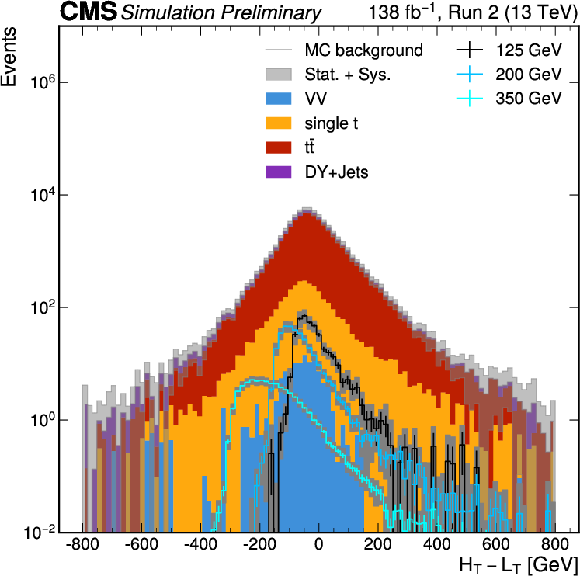
png pdf |
Figure 2-c:
Histograms for search-specific variables after object selections including a single muon requirement and categorization into both jet multiplicities in Run 2 simulation. HT−LT distributions are on the left, pmissT/mℓℓ distributions on the right. 1-jet category distributions are on top, 2-jet category distributions on the bottom. |

png pdf |
Figure 2-d:
Histograms for search-specific variables after object selections including a single muon requirement and categorization into both jet multiplicities in Run 2 simulation. HT−LT distributions are on the left, pmissT/mℓℓ distributions on the right. 1-jet category distributions are on top, 2-jet category distributions on the bottom. |
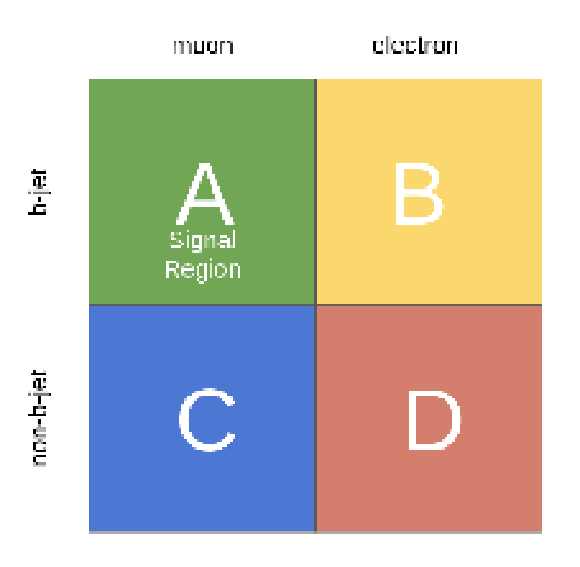
png pdf |
Figure 3:
A visual demonstration of the ABCD control regions and signal regions. For example, 'A' represents our dimuon, b-enriched signal regions (SRμμb or SRμμb+j/b), 'B' represents our b-enriched, dielectron control regions (CReeb or CReeb+j/b), and so forth. |
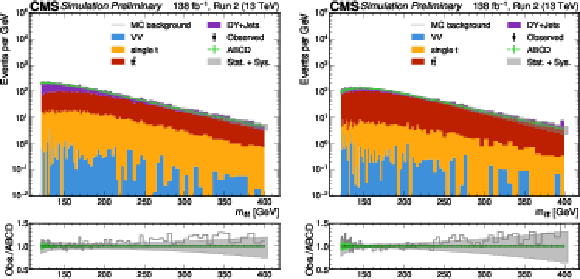
png pdf |
Figure 4:
Comparison between MC distribution in the signal region and background prediction from the ABCD method applied to MC control regions. Left: SRμμb. Right: SRμμb+j/b. |

png pdf |
Figure 4-a:
Comparison between MC distribution in the signal region and background prediction from the ABCD method applied to MC control regions. Left: SRμμb. Right: SRμμb+j/b. |
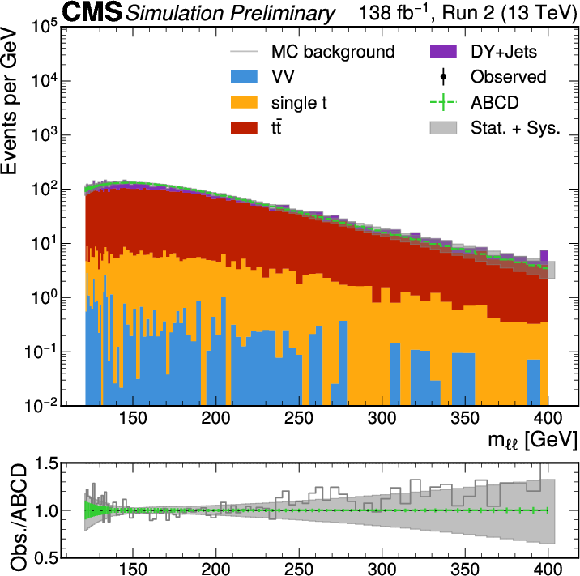
png pdf |
Figure 4-b:
Comparison between MC distribution in the signal region and background prediction from the ABCD method applied to MC control regions. Left: SRμμb. Right: SRμμb+j/b. |

png pdf |
Figure 5:
1-jet control regions with data fits used for the SRμμb background prediction. Left: CRμμj. Middle: CReeb. Right: CReej. |

png pdf |
Figure 5-a:
1-jet control regions with data fits used for the SRμμb background prediction. Left: CRμμj. Middle: CReeb. Right: CReej. |
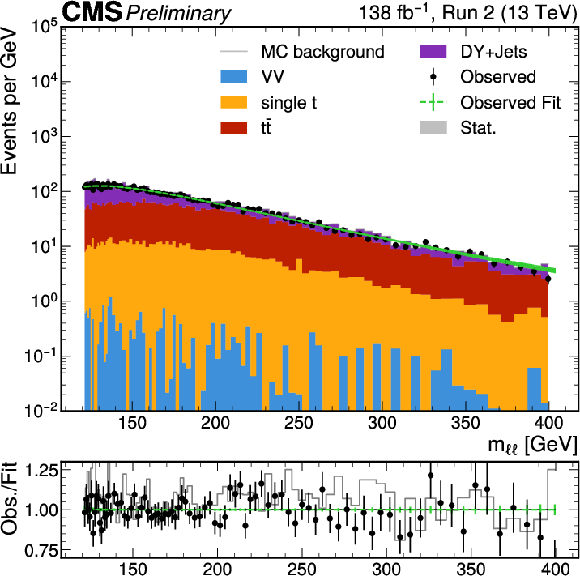
png pdf |
Figure 5-b:
1-jet control regions with data fits used for the SRμμb background prediction. Left: CRμμj. Middle: CReeb. Right: CReej. |
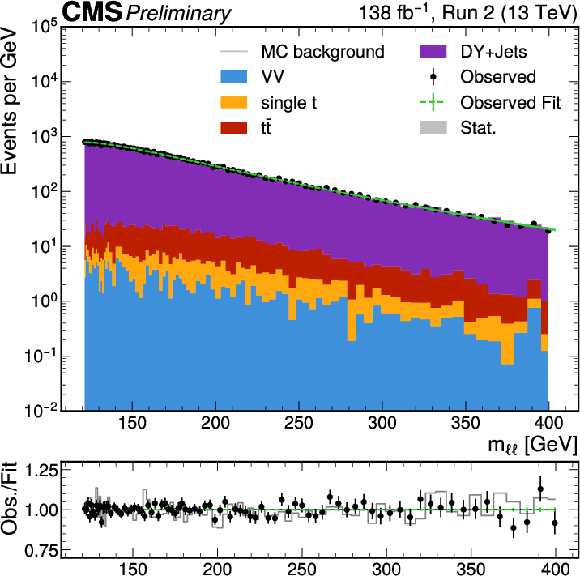
png pdf |
Figure 5-c:
1-jet control regions with data fits used for the SRμμb background prediction. Left: CRμμj. Middle: CReeb. Right: CReej. |

png pdf |
Figure 6:
2-jet control regions with data fits used for the SRμμb+j/b background prediction. Left: CRμμ2j. Middle: CReeb+j/b. Right: CRee2j. |
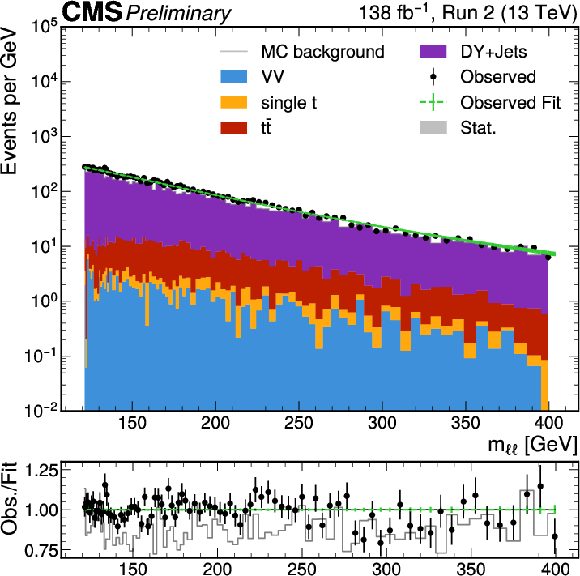
png pdf |
Figure 6-a:
2-jet control regions with data fits used for the SRμμb+j/b background prediction. Left: CRμμ2j. Middle: CReeb+j/b. Right: CRee2j. |
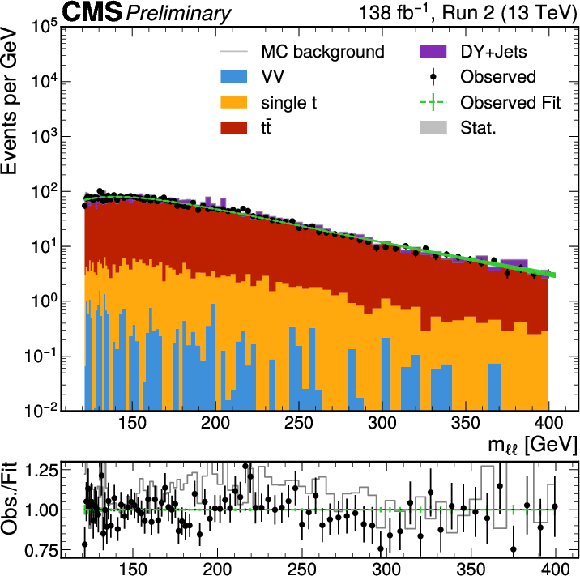
png pdf |
Figure 6-b:
2-jet control regions with data fits used for the SRμμb+j/b background prediction. Left: CRμμ2j. Middle: CReeb+j/b. Right: CRee2j. |
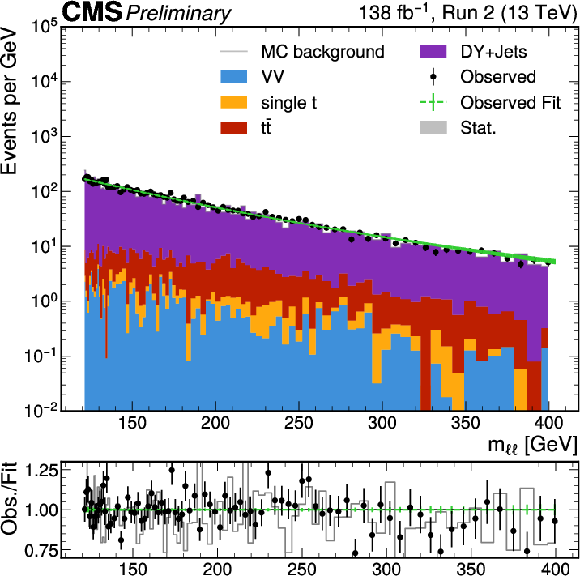
png pdf |
Figure 6-c:
2-jet control regions with data fits used for the SRμμb+j/b background prediction. Left: CRμμ2j. Middle: CReeb+j/b. Right: CRee2j. |
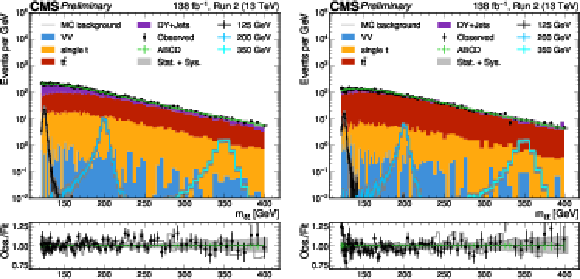
png pdf |
Figure 7:
Distributions of mℓℓ in the SRμμb (left) and SRμμb+j/b (right) signal regions. Simulated signal shapes at 125, 250 and 350 GeV are shown. |
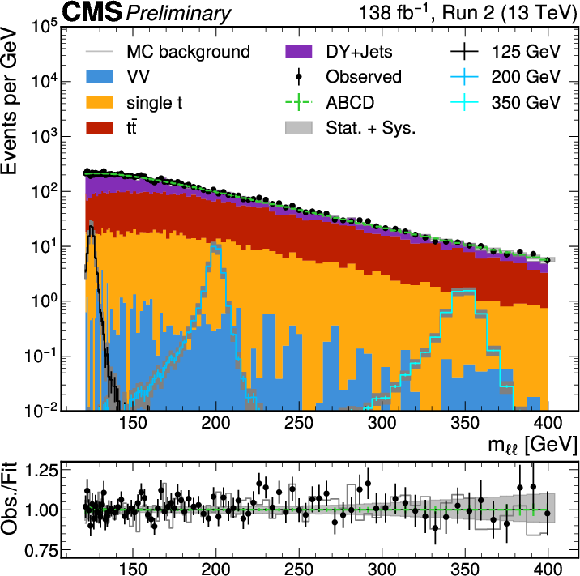
png pdf |
Figure 7-a:
Distributions of mℓℓ in the SRμμb (left) and SRμμb+j/b (right) signal regions. Simulated signal shapes at 125, 250 and 350 GeV are shown. |

png pdf |
Figure 7-b:
Distributions of mℓℓ in the SRμμb (left) and SRμμb+j/b (right) signal regions. Simulated signal shapes at 125, 250 and 350 GeV are shown. |

png pdf |
Figure 8:
Data (black) vs ABCD prediction (red) for 2016 (left), 2017 (middle), and 2018 (right) in SRμμb. The gray band shows the propagated uncertainty of all individual fit variations in a given bin, which we consider to be uncorrelated. The red error bars indicate the ABCD fit uncertainty. |

png pdf |
Figure 8-a:
Data (black) vs ABCD prediction (red) for 2016 (left), 2017 (middle), and 2018 (right) in SRμμb. The gray band shows the propagated uncertainty of all individual fit variations in a given bin, which we consider to be uncorrelated. The red error bars indicate the ABCD fit uncertainty. |

png pdf |
Figure 8-b:
Data (black) vs ABCD prediction (red) for 2016 (left), 2017 (middle), and 2018 (right) in SRμμb. The gray band shows the propagated uncertainty of all individual fit variations in a given bin, which we consider to be uncorrelated. The red error bars indicate the ABCD fit uncertainty. |
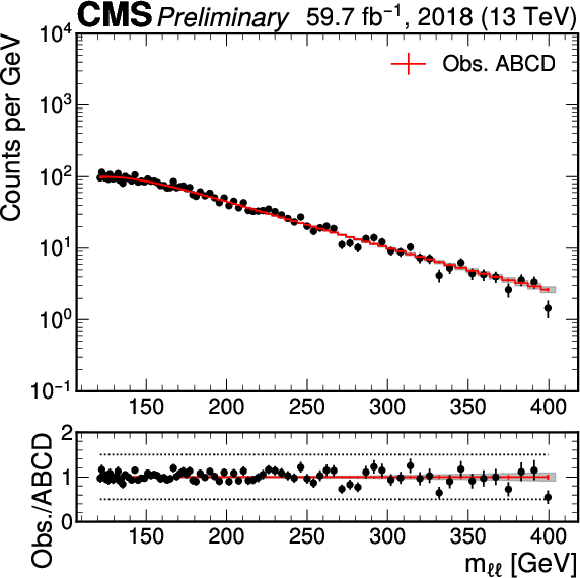
png pdf |
Figure 8-c:
Data (black) vs ABCD prediction (red) for 2016 (left), 2017 (middle), and 2018 (right) in SRμμb. The gray band shows the propagated uncertainty of all individual fit variations in a given bin, which we consider to be uncorrelated. The red error bars indicate the ABCD fit uncertainty. |

png pdf |
Figure 9:
Data (black) vs ABCD prediction (red) for 2016 (left), 2017 (middle), and 2018 (right) in SRμμb+j/b. The gray band shows the propagated uncertainty of all individual fit variations in a given bin, which we consider to be uncorrelated. The red error bars indicate the ABCD fit uncertainty. |
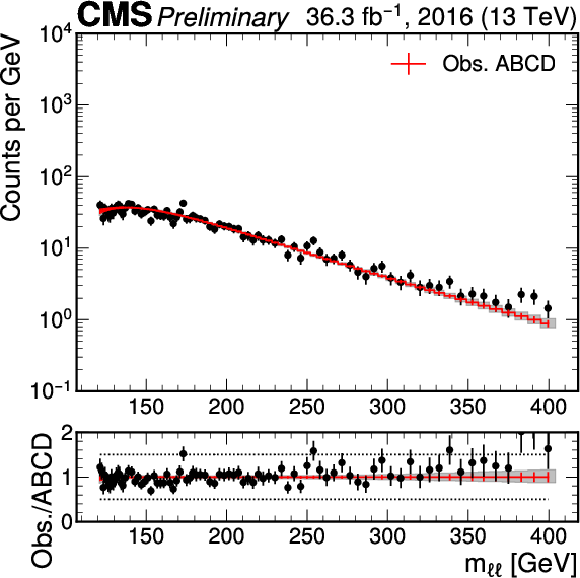
png pdf |
Figure 9-a:
Data (black) vs ABCD prediction (red) for 2016 (left), 2017 (middle), and 2018 (right) in SRμμb+j/b. The gray band shows the propagated uncertainty of all individual fit variations in a given bin, which we consider to be uncorrelated. The red error bars indicate the ABCD fit uncertainty. |

png pdf |
Figure 9-b:
Data (black) vs ABCD prediction (red) for 2016 (left), 2017 (middle), and 2018 (right) in SRμμb+j/b. The gray band shows the propagated uncertainty of all individual fit variations in a given bin, which we consider to be uncorrelated. The red error bars indicate the ABCD fit uncertainty. |
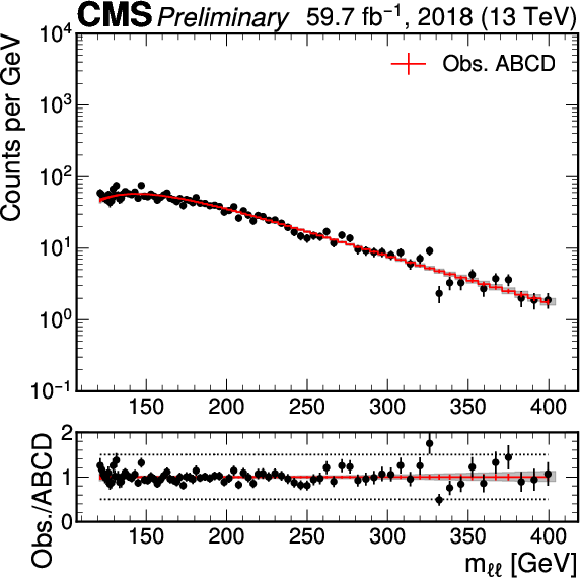
png pdf |
Figure 9-c:
Data (black) vs ABCD prediction (red) for 2016 (left), 2017 (middle), and 2018 (right) in SRμμb+j/b. The gray band shows the propagated uncertainty of all individual fit variations in a given bin, which we consider to be uncorrelated. The red error bars indicate the ABCD fit uncertainty. |
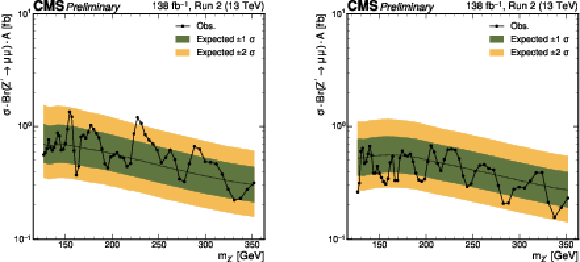
png pdf |
Figure 10:
95% confidence level limits on acceptance times cross section times branching fraction to dimuon decays. Left is SRμμb, right is SRμμb+j/b. A combination of both limits depends on the relative acceptance contributions in each region and is omitted here. |
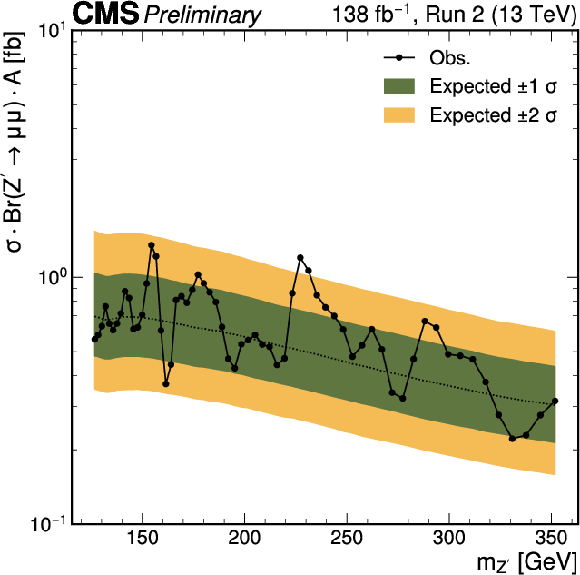
png pdf |
Figure 10-a:
95% confidence level limits on acceptance times cross section times branching fraction to dimuon decays. Left is SRμμb, right is SRμμb+j/b. A combination of both limits depends on the relative acceptance contributions in each region and is omitted here. |

png pdf |
Figure 10-b:
95% confidence level limits on acceptance times cross section times branching fraction to dimuon decays. Left is SRμμb, right is SRμμb+j/b. A combination of both limits depends on the relative acceptance contributions in each region and is omitted here. |
| Tables | |

png pdf |
Table 1:
Summary of object selection requirements on leptons, veto leptons, and jets passing and failing b-jet identification. The efficiencies of the respective identification working points are detailed in the text of Section 2. |
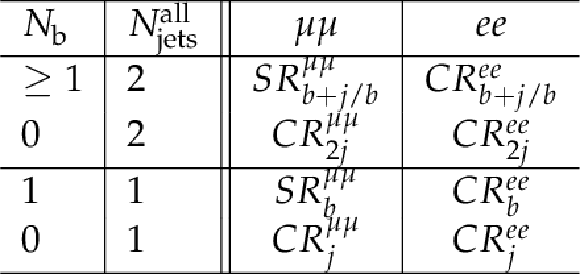
png pdf |
Table 2:
Signal and control regions based on opposite sign dilepton pair flavour and jet multiplicity, b-tagged (Nb) and total (Nalljets). Events with more than two leptons passing veto lepton selections of any flavour are discarded. Note that the signal model Z' does not decay into electrons, hence the use of dielectron control regions. |

png pdf |
Table 3:
Summary of additional mℓℓ-dependent event selection requirements on pmissT and HT−LT to suppress backgrounds. |
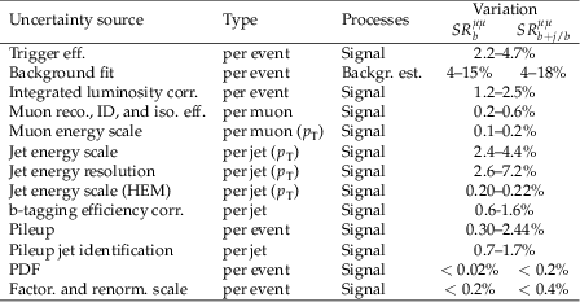
png pdf |
Table 4:
Overview of systematic uncertainty sources and their range of variation. Components of the final fit these uncertainties relate to and partial correlations across years are also indicated by a "corr." in their uncertainty source description. |
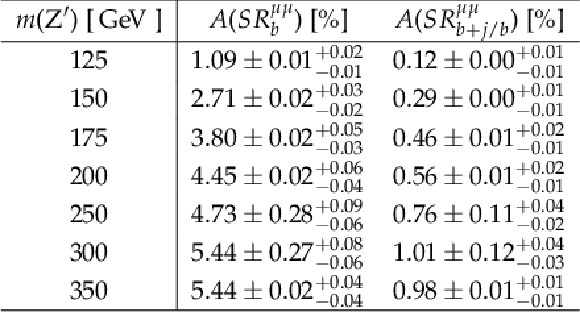
png pdf |
Table 5:
Acceptances by signal region for events with no ME generator-level ISR jets of strange or bottom flavour. Exactly one bottom quark contributes directly to the Z' production vertex. Statistical and systematic uncertainties for this 0b(1b) category are listed. |
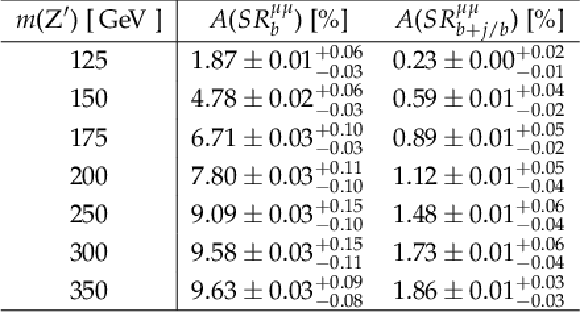
png pdf |
Table 6:
Acceptances by signal region for events with no ME generator-level ISR jets of strange or bottom flavour. Exactly two bottom quarks contribute directly to the Z' production vertex. Statistical and systematic uncertainties for this 0b(2b) category are listed. |

png pdf |
Table 7:
Acceptances by signal region for events with exactly one ME generator-level ISR jet of bottom flavour. Statistical and systematic uncertainties for this 1b category are listed. |
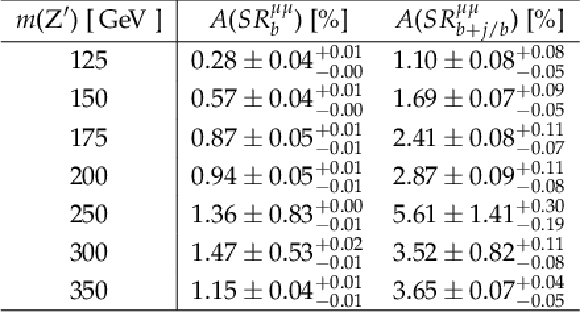
png pdf |
Table 8:
Acceptances by signal region for events with exactly one ME generator-level ISR jet of strange flavour. Statistical and systematic uncertainties for this 1s category are listed. |
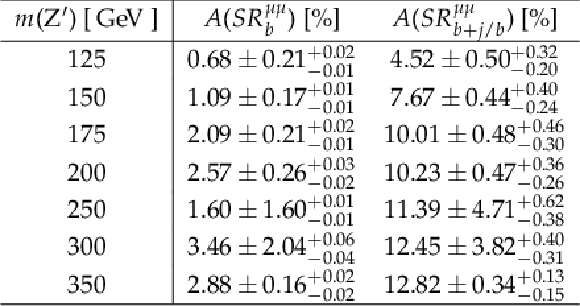
png pdf |
Table 9:
Acceptances by signal region for events with exactly two ME generator-level ISR jets, one of which has strange, the other bottom flavour. Statistical and systematic uncertainties for this 1b+1s category are listed. |
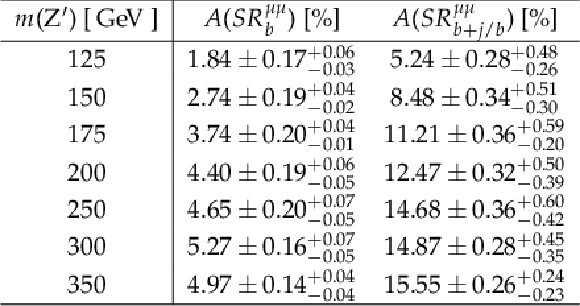
png pdf |
Table 10:
Acceptances by signal region for events with exactly two ME generator-level ISR jets of bottom flavour. Statistical and systematic uncertainties for this 2b category are listed. |
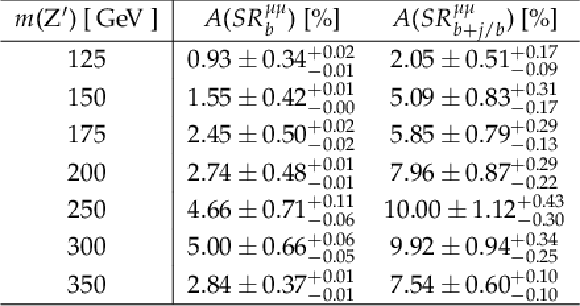
png pdf |
Table 11:
Acceptances by signal region for events with exactly two ME generator-level ISR jets of strange flavour. Statistical and systematic uncertainties for this 2s category are listed. |
| Summary |
| A search for lepton flavour universality violation by a new neutral gauge boson decaying to two muons with one or two associated jets, out of which at least one is b-tagged, has been presented. The basis for the analysis is LHC proton-proton collision data collected by the CMS experiment from 2016--2018, corresponding to an integrated luminosity of 137.58 fb−1. Data are consistent with background only, with no evidence of a signal. The limits obtained are the only ones for √s= 13 TeV for masses between 126.7 and 351.8 GeV, and they are the most stringent for masses between 200 and 351.8 GeV. The data have been presented in a model-independent way, with acceptances reported by production category as a function of Z' mass, to cover any mixture of b- and s-quark production of that possible Z'. |
| References | ||||
| 1 | ATLAS Collaboration | Search for high-mass dilepton resonances using 139 fb−1 of pp collision data collected at √s=13 TeV with the ATLAS detector | PLB 796 (2019) 68 | 1903.06248 |
| 2 | ATLAS Collaboration | Search for new non-resonant phenomena in high-mass dilepton final states with the ATLAS detector | JHEP 11 (2020) 005 | 2006.12946 |
| 3 | CMS Collaboration | Search for resonant and nonresonant new phenomena in high-mass dilepton final states at √s= 13 TeV | JHEP 07 (2021) 208 | CMS-EXO-19-019 2103.02708 |
| 4 | M. Abdullah et al. | Bottom-quark fusion processes at the LHC for probing Z' models and B -meson decay anomalies | PRD 97 (2018) 075035 | 1707.07016 |
| 5 | CMS Collaboration | Search for a high-mass dimuon resonance produced in association with b quark jets at √s= 13 TeV | JHEP 10 (2023) 043 | CMS-EXO-22-016 2307.08708 |
| 6 | Y. Amhis et al. | Averages of b-hadron, c-hadron, and τ-lepton properties as of 2021 | PRD 107 (2023) 052008 | 2206.07501 |
| 7 | CMS Collaboration | Measurement of the production cross section for Z+b jets in proton-proton collisions at √s= 13 TeV | PRD 105 (2022) 092014 | CMS-SMP-20-015 2112.09659 |
| 8 | ATLAS Collaboration | Measurements of the production cross-section for a Z boson in association with b-jets in proton-proton collisions at √s= 13 TeV with the ATLAS detector | JHEP 07 (2020) 044 | 2003.11960 |
| 9 | CMS Collaboration | The CMS experiment at the CERN LHC | JINST 3 (2008) S08004 | |
| 10 | CMS Collaboration | Performance of the CMS Level-1 trigger in proton-proton collisions at √s= 13 TeV | JINST 15 (2020) P10017 | CMS-TRG-17-001 2006.10165 |
| 11 | CMS Collaboration | The CMS trigger system | JINST 12 (2017) P01020 | CMS-TRG-12-001 1609.02366 |
| 12 | CMS Collaboration | Particle-flow reconstruction and global event description with the CMS detector | JINST 12 (2017) P10003 | CMS-PRF-14-001 1706.04965 |
| 13 | M. Cacciari, G. P. Salam, and G. Soyez | The anti-kt jet clustering algorithm | JHEP 04 (2008) 063 | 0802.1189 |
| 14 | M. Cacciari, G. P. Salam, and G. Soyez | FastJet user manual | EPJC 72 (2012) 1896 | 1111.6097 |
| 15 | CMS Collaboration | Jet energy scale and resolution in the CMS experiment in pp collisions at 8 TeV | JINST 12 (2017) P02014 | CMS-JME-13-004 1607.03663 |
| 16 | CMS Collaboration | Performance of missing transverse momentum reconstruction in proton-proton collisions at √s= 13 TeV using the CMS detector | JINST 14 (2019) P07004 | CMS-JME-17-001 1903.06078 |
| 17 | CMS Collaboration | Identification of heavy-flavour jets with the CMS detector in pp collisions at 13 TeV | JINST 13 (2018) P05011 | CMS-BTV-16-002 1712.07158 |
| 18 | E. Bols et al. | Jet Flavour Classification Using DeepJet | JINST 15 (2020) P12012 | 2008.10519 |
| 19 | CMS Collaboration | Performance of the DeepJet b tagging algorithm using 41.9/fb of data from proton-proton collisions at 13 TeV with Phase 1 CMS detector | CMS Detector Performance Note CMS-DP-2018-058, 2018 CDS |
|
| 20 | CMS Collaboration | Pileup mitigation at CMS in 13 TeV data | JINST 15 (2020) P09018 | CMS-JME-18-001 2003.00503 |
| 21 | CMS Collaboration | Electron and photon reconstruction and identification with the CMS experiment at the CERN LHC | JINST 16 (2021) P05014 | CMS-EGM-17-001 2012.06888 |
| 22 | CMS Collaboration | ECAL 2016 refined calibration and Run2 summary plots | CMS Detector Performance Summary CMS-DP-2020-021, 2020 CDS |
|
| 23 | CMS Collaboration | Performance of the CMS muon detector and muon reconstruction with proton-proton collisions at √s= 13 TeV | JINST 13 (2018) P06015 | CMS-MUO-16-001 1804.04528 |
| 24 | CMS Collaboration | Performance of electron reconstruction and selection with the CMS detector in proton-proton collisions at √s= 8 TeV | JINST 10 (2015) P06005 | CMS-EGM-13-001 1502.02701 |
| 25 | J. Alwall et al. | MadGraph 5: Going Beyond | JHEP 06 (2011) 128 | 1106.0522 |
| 26 | NNPDF Collaboration | Parton distributions for the LHC Run II | JHEP 04 (2015) 040 | 1410.8849 |
| 27 | NNPDF Collaboration | Parton distributions from high-precision collider data | EPJC 77 (2017) 663 | 1706.00428 |
| 28 | T. Sjostrand, S. Mrenna, and P. Z. Skands | A Brief Introduction to PYTHIA 8.1 | Comput. Phys. Commun. 178 (2008) 852 | 0710.3820 |
| 29 | CMS Collaboration | Event generator tunes obtained from underlying event and multiparton scattering measurements | EPJC 76 (2016) 155 | CMS-GEN-14-001 1512.00815 |
| 30 | CMS Collaboration | Extraction and validation of a new set of CMS PYTHIA8 tunes from underlying-event measurements | EPJC 80 (2020) 4 | CMS-GEN-17-001 1903.12179 |
| 31 | GEANT4 Collaboration | GEANT4--a simulation toolkit | NIM A 506 (2003) 250 | |
| 32 | CMS Collaboration | Precision luminosity measurement in proton-proton collisions at √s= 13 TeV in 2015 and 2016 at CMS | EPJC 81 (2021) 800 | CMS-LUM-17-003 2104.01927 |
| 33 | CMS Collaboration | CMS luminosity measurement for the 2017 data-taking period at √s= 13 TeV | CMS Physics Analysis Summary, 2018 link |
CMS-PAS-LUM-17-004 |
| 34 | CMS Collaboration | CMS luminosity measurement for the 2018 data-taking period at √s= 13 TeV | CMS Physics Analysis Summary, 2019 link |
CMS-PAS-LUM-18-002 |
| 35 | CMS Collaboration | Measurement of the inelastic proton-proton cross section at √s= 13 TeV | JHEP 07 (2018) 161 | CMS-FSQ-15-005 1802.02613 |
| 36 | PDF4LHC Working Group Collaboration | The PDF4LHC21 combination of global PDF fits for the LHC Run III | J. Phys. G 49 (2022) 080501 | 2203.05506 |

|
Compact Muon Solenoid LHC, CERN |

|

|

|

|

|

|